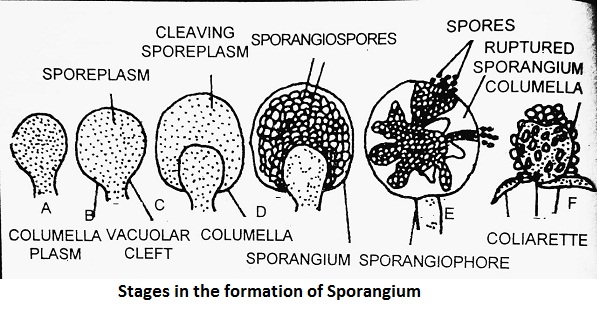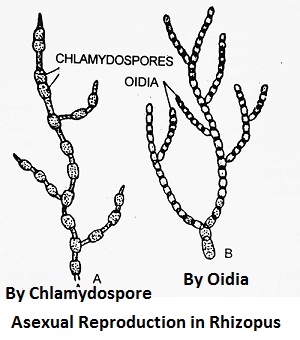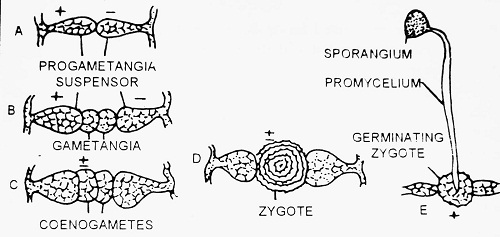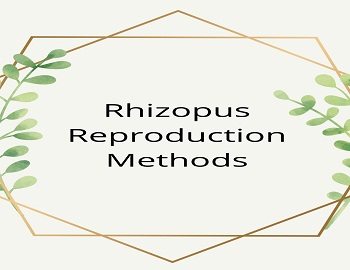Table of Contents
Rhizopus Reproduction Methods:
Rhizopus reproduces by following methods-
Vegetative Reproduction:
Vegetative Reproduction takes place by fragmentation. The hyphae break up into small pieces called fragments. Each fragment by apical growth and branching forms a new mycelium under favourable conditions.
Asexual Reproduction:
Asexual Reproduction takes place under favourable conditions of temperature and moisture. It takes place as an under-
(I) By Spore Formation- Under favourable conditions of food, water and temperature Rhizopus reproduce asexually by the formation of spores which are small multi-nucleate ovoid and non-motile structures. These are formed as black rounded bodies within the sporangia and thus, they are also known as sporangiospores. The formation of sporangia takes place in the following steps-
- Development of Sporangiophores- From the apparent nodes on the stolen arise aerial hyphae called sporangiophores.
- Cytoplasmic Migration- The cytoplasm along with nuclei migrates towards the tip of the sporangiphore which swells up into a spherical sac.
- Vacuolization- Inside the swollen tip, the process of vacuolization takes place so that a central sterile vacoulated mass of cytoplasm called columella-plasm and outer denser multinucleated fertile mass called sporeplasm are produced. At the union of two regions, small vacuoles appear which fuse to form a furrow between the two.
- Columella Formation- A semi-circular wall is sectred in the furrow between columellaplasm and sporeplasm which leads to the formation of central dome-shpaed columella and process is called columelization.
- Nuclear Paretalization- In the sporeplasm, the number of nuclei increases by mitotic divisions and they get arranged from periphery to the centre.
- Cytoplasmic Clevage- The multinucleate sporeplasm undergoes centripetal clevage forming a number of multinucleate polyhedral protoplast segments which develop into spores. This structure bearing spores is now knwon as sporangium. The wall of sporangium is very fragile and ruptures on slight touch and spores are released.

(II) By Chlamydospores– Sometimes, Rhizopus reproduced by chlamydospores. Under favourable conditions, the hypha gets segmented into a chain of many cells and forms thick-walled, rounded Chlamydospores. They remain viable for many years and on the approach of favourable conditions, they germinate to give rise to the same type of mycelium.
(III) By Oidia- When hyphae are kept in a nutritive medium, oidia are formed. These separate and multiply by budding to give rise to new mycelia.

Sexual Reproduction:
Sexual Reproduction takes place by conjugation. Rhizopus is usually a heterothallic fungus as it contains two different types of physiological strains (positive and negative). It can reproduce sexually only if the positive and negative strains are growing very near to each other.
When the hyphae of two different strains are growing together, they produce the hormone called Gamone. The positive gamone reacts with the negative hyphae and the negative gamone reacts with the positive hyphae. In response to this reaction, the hyphae produce erect aerial branches called positive and negative zygophores. These zygophores come in contact with each other and by rubbing effect produces the side protuberances known as progametangia. The cytoplasm along with nuclei migrates into this progametangia whose tips become swollen. The swollen tip is separated from the rest by the septum. This swollen part is called Gametangia and the short stalks are called suspensors. Each gametangium produces a single gamete which is multinucleated. Such a type of gamete having an undifferentiated mass of cytoplasm is called Coenogamete. The intervening wall between the two Gametangia dissolves and the two coenogametes fuse together forming a multinucleated Zygote. The positive strain nuclei fuse with the negative strain nuclei. The zygote secretes a thick and rough wall around it and forms a zygospore that can survive adverse climatic conditions.
Germination of Zygospore- After undergoing a period of rest, Zygospore develops. Its outer wall ruptures and the inner grow out into a tube called Promycellium or Sporangiphore which bear at its tip a spherical body called Sporangium.
Sporangium- It bears numerous small spores which on germination give rise to new hyphae.










Comments (No)